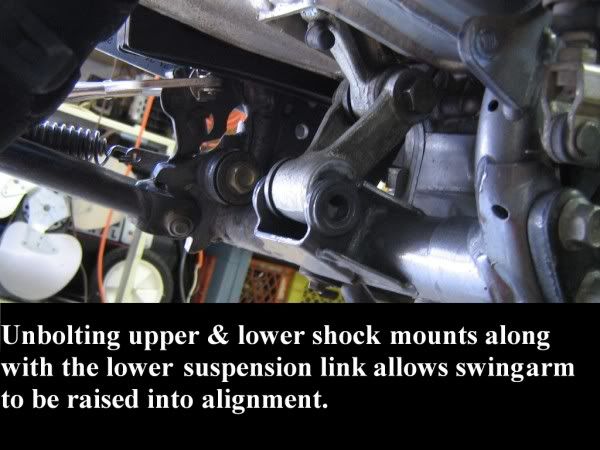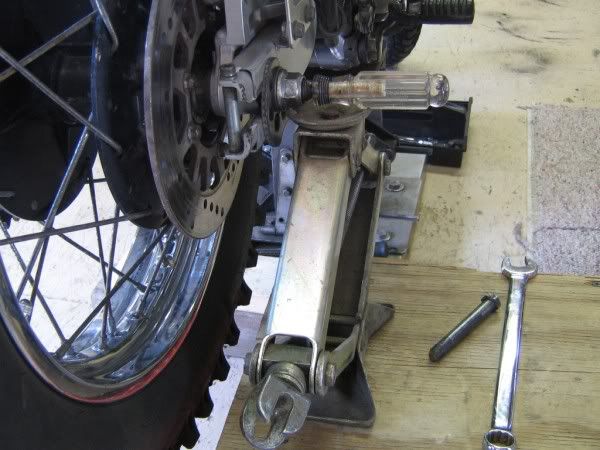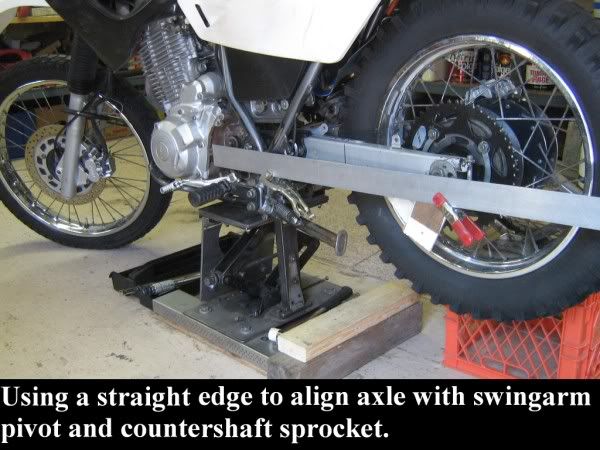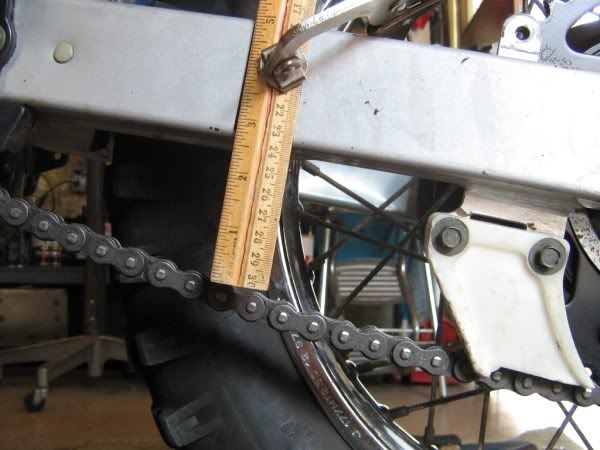Post by bultaco on Dec 16, 2008 16:56:03 GMT -8
To properly adjust your chain you must first determine minimum chain slack,
(you will only have to do this once) place the bike on a crate or on it's
centerstand so the rear suspension is fully extended, remove the shock or
unbolt the shock in such a way that allows the swingarm to move freely upward.

Using a scissor jack raise the swingarm up until the countershaft sprocket,
swingarm pivot and rear axle are all perfectly aligned, If your axle is hollow you can
place a screwdriver in the axle as a point to jack from or mount a "C" clamp
to the swingarm.




Before adjusting the chain make sure your swingarm pivot and rear axle are parallel.
Axle Alignment
With the alignment established adjust your chain with a small amount of slack, say 1/2" of
movement, spin the wheel so you can get a good feel for how tight the chain is, chains do not
wear (stretch) evenly thus when you make your measurement it should be done at the chains
tightest point. That is to say rotate the wheel and feel the slack at your measuring point until
you can identify the spot in the chain that has the least amount of slack. tighten the adjusters
and axle tight, reinstall the shock, now you can take the measurments you'll be using for your
regular chain adjustment.

Align ruler with the top of the lower run of chain in it's resting position

Maintaining this amount of minimum chain slack will always ensure against an over tight
chain. run slightly more slack if your riding in mud.


Always measure in the same spot and always use the lower run of chain, somewhere near the
middle of the chain make a mark on the swingarm, or use any identifying mark that you'll
remember, with the ruler in your hand set it on your mark and hold it flat against the
swingarm, slide the ruler down so it's now level with the chain, holding the ruler with
one hand use your other hand to push the chain up toward the ruler and note the amount of
movement, this distance will always be your minimum chain slack, increase this amount for
riding in mud, from this point on it's a piece of cake checking if your chain needs adjusting.


(you will only have to do this once) place the bike on a crate or on it's
centerstand so the rear suspension is fully extended, remove the shock or
unbolt the shock in such a way that allows the swingarm to move freely upward.

Using a scissor jack raise the swingarm up until the countershaft sprocket,
swingarm pivot and rear axle are all perfectly aligned, If your axle is hollow you can
place a screwdriver in the axle as a point to jack from or mount a "C" clamp
to the swingarm.




Before adjusting the chain make sure your swingarm pivot and rear axle are parallel.
Axle Alignment
With the alignment established adjust your chain with a small amount of slack, say 1/2" of
movement, spin the wheel so you can get a good feel for how tight the chain is, chains do not
wear (stretch) evenly thus when you make your measurement it should be done at the chains
tightest point. That is to say rotate the wheel and feel the slack at your measuring point until
you can identify the spot in the chain that has the least amount of slack. tighten the adjusters
and axle tight, reinstall the shock, now you can take the measurments you'll be using for your
regular chain adjustment.

Align ruler with the top of the lower run of chain in it's resting position

Maintaining this amount of minimum chain slack will always ensure against an over tight
chain. run slightly more slack if your riding in mud.


Always measure in the same spot and always use the lower run of chain, somewhere near the
middle of the chain make a mark on the swingarm, or use any identifying mark that you'll
remember, with the ruler in your hand set it on your mark and hold it flat against the
swingarm, slide the ruler down so it's now level with the chain, holding the ruler with
one hand use your other hand to push the chain up toward the ruler and note the amount of
movement, this distance will always be your minimum chain slack, increase this amount for
riding in mud, from this point on it's a piece of cake checking if your chain needs adjusting.


